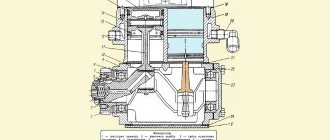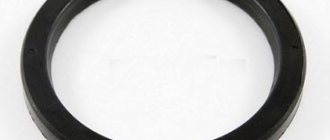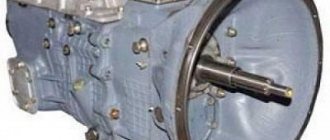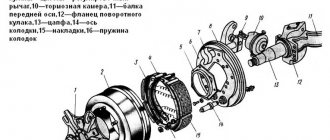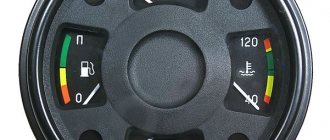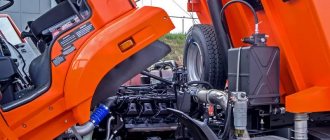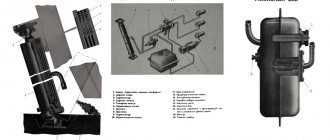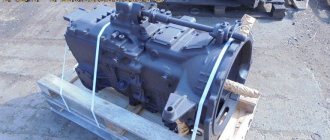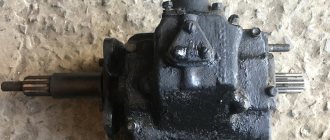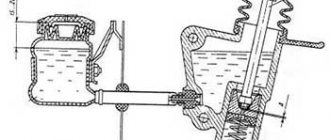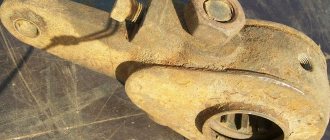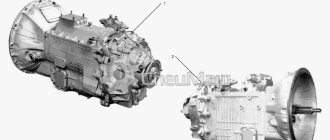The KamAZ-5320 gearbox consists of a three-shaft, three-way, five-speed main gearbox and a front two-shaft gearbox-divider.
Thus, the box provides ten forward gears and two reverse gears. Some modifications of the car are equipped with five-speed gearboxes without a gear divider. The constant-mesh gears in the gear section are helical, while the first gear and reverse gear are spur gears. The main box is equipped with two inertia-type synchronizers for engaging fifth, fourth, third and second gears. First gear and reverse gear are engaged by a gear clutch. Switching in the gearbox-divider is carried out by an inertial-type synchronizer. Synchronizers are used to equalize the rotation speeds of the engaged gears, which reduces noise when changing gears and increases the durability of the gears. Synchronizers are of great importance for remote or automatic control. The primary and secondary shafts of the main box are secured against axial displacement by ball bearings, and the intermediate shaft by a spherical roller bearing. The reverse gear block is mounted on an axle on two roller bearings.
Design and principle of operation
Let's consider the location and design of the KamAZ vehicle gearbox. KamAZ trucks are equipped with manual transmissions. They have 5 speeds. The gearbox is switched by pressing the clutch pedals and moving the gearshift lever to the desired position. Since the car is heavy, it is necessary to transfer the gearbox from one gear to another in several stages.
The principle of operation of the KamAZ gearbox is as follows: with a diesel engine it works either in high mode B or in low mode H. They were created to reduce the load on the engine of a heavy vehicle when it is full, and at the same time not force it to work too actively without load.
The design of a KamAZ gearbox with a divider is simple, but it differs depending on the model of the gearbox. Let's look at the KamAZ gearbox diagram, which is found on diesel vehicles. When driving on a flat road, you need to change gears without a clutch. The design of the KamAZ transfer case can be represented by the following formula: 1B - 2B - 3B - 4H - 4B - 5H - 5B.
Switching speeds is carried out as follows:
- First, switch the gearbox operating mode from high to low using a lever.
- Then release the clutch.
- The lever is set to the desired gear, without jumping over them, but turning everything on in order.
There are gearboxes with automatic mode switching.
KAMAZ gearbox device
The gearboxes that KAMAZ vehicles are equipped with are fundamentally no different from similar units of other tractors. However, they are not interchangeable and have certain design features.
The most common two variants of the KAMAZ gearbox are the 14th (141, 142, 144) and 15th (152, 154) models.
Three shafts are installed in the crankcase of both boxes:
- leading;
- intermediate;
- slave.
Like any modern manual transmission, they are equipped with synchronizers and have a gear transmission. Reverse gears are installed in a separate block. The speed change mechanism is located in a separate block, which is located in the upper part of the box.
Specifications
The KamAZ gearbox with a divider includes the following elements:
- a crankcase in which the drive, driven and intermediate shafts assembled with gears are mounted;
- bearings;
- synchronizers,
- reverse gear block,
- top cover of the box,
- gear shift mechanism.
The gearbox of KamAZ vehicles can be five- or ten-speed. The gearbox divider has high and low gears and, in combination with the main gearbox, allows for 10 forward gears and 2 reverse gears. The divider system improves the traction qualities of the machine, makes it easier to control, and reduces the frequency of shifting gears with a lever. Transmission ratios are available in the operating instructions for the device.
The 141 KamAZ gearbox has a reversing light switch. To prevent the simultaneous activation of 2 gears, there is a ball-type lock in the cover, and a spring-finger fuse is used to prevent accidental engagement of reverse gear. The gearbox with divider weighs 320 kg. The cuffs are located in the shaft covers. They protect the gearbox from clogging and prevent oil leakage. Insufficient oil volume in the gearbox leads to its damage. When you first fill the gearbox there should be 9 liters of oil, when changing the fluid - 8 liters.
Technical characteristics of the KamAZ-141 gearbox:
- The diameter of the bearing bore is 150 mm.
- The diameter of the hole in the gear block axis is 32 mm.
- The diameter of the front bearing journal is 24 mm.
- Rear bearing - 59 mm.
The secondary shaft has the following diameters for the parts:
- Fourth gear gear bushings - 63 mm.
- Roller bearings - 80 mm.
- Reverse gear bushings - 70 mm.
- The outer diameter of the sleeve is 72 mm.
- The diameter of the front bearing journal is 65 mm, the rear one is 49 mm.
- The diameter of the rear bearing cup is 119 mm.
- The diameter of the intermediate shaft is 65 mm.
- The inner diameter of the gear is 65 mm.
The weight of the gearbox with divider is 320 kg.
Description of the vehicle, technical and operational characteristics
Overall dimensions and load capacity of KamAZ-5320
- Chassis length: 3,435 millimeters;
- Vehicle width, excluding mirrors: 2,500 mm;
- Vehicle height: 3,350;
- Minimum overall turning radius: 9.3 meters;
- Curb weight of the tractor: 7,080 kilograms;
- Load capacity: 8 tons;
- Total weight: 15,100 kilograms;
- Weight of the tractor as part of a road train: 26.8 tons;
- Maximum climbable grade: 30 0 ;
- Braking distance at 60/hour: 36 seconds;
- Cruising speed: 80 km/h.
Power unit and fuel consumption of KamAZ-5320
The majority of KamAZ-5320 vehicles are driven by a KamAZ-740.10 diesel engine. This eight-cylinder power unit has a V-shaped arrangement of cylinders, with a displacement of 10.86 liters and a rated power of 210 horsepower. The engine is equipped with an automatic all-mode speed controller and a dry air filter with a clogging indicator. In the basic configuration, the car is equipped with a PZD-30 preheater. Smooth and uninterrupted operation of the engine is ensured by a fuel injection advance clutch and an electric flare device. An undoubted innovation for that time was the installation of a nitrided crankshaft and a full-flow oil filtration system with a centrifuge. In terms of environmental parameters, KamAZ-740.10 meets the requirements of the Euro 1 standard.
How to change gears on KamAZ
To change gears correctly, you need to know how the transmission works. The gearbox is designed in such a way that movement is often carried out at a reduced speed, so the machine can transport heavy loads. KamAZ has a 5-speed gearbox. You need to change gears using the clutch pedal and lever.
Start of movement
Before you start moving, you must press the reduced speed. Shift gears only with the clutch pedal depressed. The gear shift pattern is based on staged gear shifting. To start driving a truck, you need to spin the crankshaft of the internal combustion engine.
The second gear must be engaged when the needle on the tachometer reaches mark 3, which means 3000 rpm. This method of gear shifting will make it possible to extend the life of the gearbox and reduce gasoline consumption.
Switching speeds
Let's consider the procedure for switching gears after the car has already started moving. When KamAZ accelerates, the gear shift order is: 4H - 4B - 5H. To engage speed 2, the crankshaft speed must increase to 3000 rpm according to the tachometer readings. The functions of the crankshaft are basic.
Reverse
To engage reverse on a truck, you need to place the switch in the lower left position. Reverse gear cannot be engaged while the vehicle is moving. To engage reverse, you must first completely stop the unit, then perform a maneuver.
Instructions for shifting gearbox
Operation of the transmission includes three main nuances:
- correct start of movement;
- features of selecting and switching speeds;
- using reverse gear.
Getting started: at what speed should you start?
After the engine has been started and the motor has begun to operate, driving should begin in a low gear. When moving away, you only need to engage the speed with the clutch disengaged.
On transmissions of KamAZ vehicles, the gear shift diagram is carried out in a certain sequence:
- At the first stage after starting to move, you need to engage gear 1B (increased first speed mode).
- As the speed increases, the lever switches to 2B mode.
- At the last stage of starting, the 3B gear is activated.
Accordingly, on the main box there is no need to touch the lever up to the fourth speed. To start driving, you need to increase the crankshaft speed to 7 thousand revolutions per minute.
It is important to know
Switching to second gear while driving is possible only after the number of revolutions on the tachometer reaches 3 thousand/min.
How to change speeds correctly?
After acceleration, the order in which the speeds are turned on will be as follows:
- There is a transition to the second lower stage and activation of the fourth speed (4H).
- Then the primary stage is activated, while the movement speed must remain fourth (4B).
- At the next stage, you need to go to a lower gear and activate the fifth speed (5H).
- The driver then returns to the higher gear, but the vehicle continues to move at fifth speed (5B).
How to turn on reverse?
Reverse must be engaged by moving the gearbox lever to the lower left position. Activation of reverse gear is not permitted while driving or if the vehicle is rolling. To engage reverse gear, you need to completely stop the vehicle and then perform the maneuver.
Video: rules for shifting gears on KamAZ
Nikita Vagin in his video spoke in detail about how many speeds there are in KamAZ, as well as about the scheme and nuances of switching them
Switching rules under different conditions
Gear changes depend on the various conditions in which the vehicle is moving. These rules should be followed so that during the use of the gearbox it does not fail.
Climb
During an ascent, you must switch the gearbox to mode H, as a result of which the transmission will begin to operate at increased voltage.
The following rules must be followed:
- When switching from 1st to 2nd gear when ascending a KamAZ truck, you must use the method of depressing the clutch pedal twice.
- In order for the crankshaft to work correctly when changing gears, you need to use the fuel pedal; it also needs to be pressed periodically. At the same time, you can overcome any steepest climb.
- The shaft speed when lifting must be more than 2000 rpm. Otherwise, the engine may shut down, which may cause an accident while driving on the road.
- During the climb, switch to the desired mode, this will facilitate the operation of the engine and all components of the machine.
Descent
Some drivers turn off the engine when descending a mountain to save gas. This should not be allowed at KamAZ.
If you turn off the internal combustion engine during a trip, the electric booster will not perform its functions, which will lead to the steering wheel locking.
KamAZ braking occurs not only as a result of stopping the engine, but also by activating the auxiliary braking system. When a heavy vehicle is going downhill and the driver applies the auxiliary brakes, the clutch should not be depressed and the driver should not shift from one gear to another.
Icy areas
You need to drive a truck on icy areas with maximum speed and range. When braking, you must use the engine stop assist system. If emergency braking is required, the operator must stop the trailer wheels. If you do not take this rule into account, you may end up in a skid.
It is possible to slow down the internal combustion engine only as an exception, as this can lead to its wear. When braking, the wheels should not slip. To avoid this, you need to turn off the reduced speed, which will help reduce the rotation of the crankshaft.
Skid
When skidding, do not disengage the clutch. When the truck skids, you need to turn the steering wheel in the direction of the skid. If the KamAZ skids, you need to take your foot off the gas pedal and press the differential. This must be done using the regulator located on the panel. As a result, the indicator on the panel will turn on. You need to start the move from the second high gear. After overcoming the skid, the differential should be unlocked.
Features of electrical equipment
The designers were tasked with creating a multi-purpose vehicle capable of working in heavy duty in off-road conditions (see also the ZIL 5301 wiring diagram).
Therefore, quite a lot of attention was paid to the issue of reliability and maintenance of components and assemblies with your own hands:
- Electronic interlocks have been introduced to prevent electrical circuits from failing. In particular, a relay that prevents the “ground” from being turned off when the engine is running;
- The heating systems for the cabin and driver's seat have been tested and adopted;
- Double square-shaped headlights, new for the automotive industry, etc. have been installed.
Generator
The diesel power unit is equipped with a G-272 generator, structurally consisting of:
- Three-phase synchronous 12-pole electrical machine;
- Direct-flow ventilation;
- Built-in rectifier unit.
This generator operates in a single-wire circuit and has the following conclusions:
- The negative terminal is connected to the body (ground);
- The positive terminal is connected to the battery;
- Terminal “Ш” – for connecting a voltage regulator.
Caution: Incorrectly connecting ground to the positive terminal of the battery will damage the voltage regulator and the diodes built into the generator.
Malfunctions and repairs
Transmission repair consists of disassembling the unit, diagnosing, repairing or replacing worn elements. After the mechanism is restored, the unit is reassembled and the system is tested in operation. You can contact a service center, but it is better to repair the transfer case yourself.
How to check the oil level
The oil level in the box is checked as follows. Unscrew the crankcase plug. When checking, you must install the crankcase indicator into the hole until it stops. The oil from the crankcase of a ten-speed manual transmission is drained through 3 holes. Of these, 2 holes are located in the lower part of the gearbox housing, and the third is located in the divider. The five-speed gearbox housing is drained through 2 holes.
Change of oil
To change the oil, you need to wash the gearbox housing with engine oil. Clean the magnetic plugs from metal particles and fill in oil to the top line of the indicator. The oil level is measured after 5 minutes. When the car is moving, the gearbox should operate without hesitation, speeds should be switched freely and locked firmly. Loud noise may indicate worn shaft bearings, insufficient oil level, or poor quality lubricant in the crankcase.
How to remove the box
Removing the gearbox is carried out as follows:
- You need to remove the driveshaft. To do this, unscrew the 4 fastening nuts.
- The PSU is being removed.
- Dismantle the starter mountings.
- Disconnect the tube that goes to the reduction gear.
- Remove the gear shift lever.
- Place a jack between the flywheel and the engine pan, and dismantle the engine through a wooden stand.
- Unscrew the rear yoke nuts and remove it.
- Dismantle the spacer rod.
- Unscrew the exhaust system bracket fastening bolts.
- Connect the hoist to the bolts and tighten it.
- Unscrew the fastening nuts to the side engine mounts.
- Unscrew the bolts that secure the gearbox to the internal combustion engine.
- Raise the hoist and move the gearbox away from the engine to the output of the transmission input shaft.
- Pull out the gearbox.
How to adjust
Now you need to adjust the gearbox and troubleshoot components and parts. If they fail, replace them with new ones. Spline connections must not have defects or chips. Gear bearings should be replaced after first inspecting the place where they are installed to see if there is any wear or areas pressed through by the rollers.
The shaft bearings are replaced because, as a result of breakage and metal shavings getting into the oil, the rolling areas of the bearings were damaged, which could cause gearbox failure. Inspect the gears, detect damage and wear of gear teeth. The conical synchronizer races must not be deformed or worn. The guide shafts should not be loose. There should be no damage to the splines.
How to assemble correctly
The gearbox is assembled in the reverse order. The intermediate shaft is installed in the gearbox housing. Mount the bearings - front roller and rear spherical. Tighten the support washer. Fix it with a nut and close the rear cover of the spherical bearing mount. Install gaskets. The shaft should rotate easily, there should be no jamming of the part when moving.
How much does a box cost for KamAZ?
You can buy a gearbox for KamAZ in a specialized store, where they will show you a price list with the available models. The purchase price of a gearbox depends on the model of truck on which it will be installed. So the cost of a KamAZ gearbox ranges from 55,000 to 153,000 rubles. The price of the gearbox for KamAZ 141 is 62,000 rubles. The highest prices for KamAZ gearboxes of Euro-3 environmental class.
The Kamaz-5320 gearbox comes in two types—five-speed and ten-speed, which consists of the main five-speed Kamaz-5320 gearbox and a front two-stage gearbox-divider.
The Kamaz-5320 gearbox divider has high and low (direct) gears and, in combination with the main five-speed gearbox, allows for ten forward gears and two reverse gears.
The use of a gear divider improves the traction and economic qualities of the car, makes it easier to drive the car, since its use reduces the frequency of gear shifting with the shift lever.
The Kamaz-5320 five-speed gearbox (Fig. 1) consists of the following main components: gearbox housing 34, in which drive 1, driven 35 and intermediate 33 shafts assembled with gears, synchronizers and bearings are mounted; gear block 14 reverse; top cover 18 of the box with gear shift mechanism assembly. A clutch housing 38 is attached to the front end of the gearbox housing.
Fig.1. Gearbox KamAZ-5320
1 - drive shaft; 2 — cover of the rear bearing of the drive shaft; 3, 23 — adjusting gaskets; 4 — lever rod; 5 — protective ring; 6 — lever support cover; 7 — lever support block; 8 — sealing ring; 9 — rod support; 10 - spring; 11 — gear shift lever support; 12 — axis of the reverse gear block: 13, 31—thrust washers; 14 — reverse gear block; 15 — roller bearing: 16 — bolt with pin; 17 — lock washer; 18 — top cover; 19, 32, 36 — sealing gaskets; 20 — cover of the rear bearing of the driven shaft; 21 — retaining ring; 22 — ball bearing of the rear driven shaft: 24 — speedometer drive worm; 25, 39 — sealing cuffs; 26 — flange mounting nut; 27 — driveshaft mounting flange; 28 — cup of the rear bearing of the intermediate shaft; 29 — bearing cover; 30 — spherical roller bearing: 33 — intermediate shaft; 34- gearbox housing; 35- driven shaft; 37 — cover of the front bearing of the intermediate shaft; 38 — clutch housing; 40 — clutch release fork; 41-shaft of the clutch release fork; 42 — clutch release
The shaft bearings of the Kamaz-5320 gearbox are closed with covers with sealing gaskets. Cover 2 of the rear bearing of the drive shaft is centered with an internal bore along the outer race of the bearing; The surface of the cover, machined along the outer diameter, is the centering surface for the clutch housing.
Two self-clamping cuffs 39 are inserted into the inner cavity of the lid. The working edges of the cuffs have a right-hand notch.
The internal cavity of a larger diameter is designed to accommodate an oil injection device; Spiral blades at the end of the cover prevent the oil from spinning in the injection cavity by the oil injection ring, thereby reducing centrifugal forces, and therefore contribute to an increase in excess oil pressure in the injection cavity.
In the upper part of the Kamaz-5320 gearbox cover there is a hole for supplying lubricant from the gearbox oil accumulator to the discharge cavity.
The rear driven shaft bearing cover 20 is attached to the rear end of the transmission housing and is centered on the outer race of the rear driven shaft bearing 22. In the rear part of the Kamaz-5320 box cover there is a cuff 25 with a boot, on the working edge of which there is a left notch.
At the bottom of the cover, in a special bore, there is a roller made integral with gear 10 (Fig. 2) of the worm pair of the speedometer drive. At the protruding end of the roller, which has a flat, the drive gear 12 of the speedometer cylindrical pair is installed.
The driven spur gear 13 is installed on the speedometer drive shaft 14, which rotates in the bore of the speedometer drive sensor flange 16. The cavity of the replacement gears is isolated from the gearbox oil bath, and the gears are lubricated with grease added during assembly.
The lubricant is kept from leaking out by the oil drain thread on the roller and the cuff. To ensure correct speedometer readings, the number of teeth of the replaceable spur gears is selected depending on the final drive gear ratio.
In the bosses of the right wall of the Kamaz-5320 gearbox housing there is a boring into which axle 12 (see Fig. 1) of the reverse gear unit is pressed.
To prevent it from falling out, the axle is secured with a lock washer 17, screwed with a bolt 16, which has a drilling into which a plastic pin is inserted. The pin seals the threaded connection and prevents lubricant from leaking out.
Description of gearboxes
Structurally, the ten-speed transmission is a box with five steps and a gearbox. This design uses 10 forward gears and 2 reverse gears. The transmission is popular and is used for installation on vehicles carrying heavy loads. The mechanism received index 15.
Distinctive features of the KamAZ-15 box:
- Used in conjunction with a reinforced divider synchronizer;
- The splines have been modernized and strengthened, the fastening parts have been removed from the box;
- The fixation of transmission gears has been modernized;
- The height of the teeth has been increased.
Downshift (divider) valve for KamAZ-15:
The pneumatic system activates and controls the KamAZ transmission dividing device. The performance and durability of the unit directly depends on the correct use of this unit. For the same reason, inspection of the KamAZ transmission is carried out at specialized stations.
KamAZ transmission elements:
- Box body with built-in shafts: driving, driven, intermediate;
- Gear mechanism for activating reverse;
- Upper casing;
- Collapsible mechanism that switches stages;
- The power unit is located in the front of the body.
Box divider
High and low operating modes, a feature of KamAZ gearboxes. This specificity is caused by the desire to reduce the load on the power plant. It is typical that it does not matter whether the machine is loaded or not. A divider is a gearbox based on the principle of mechanics and increases gear ratios. The mechanism is started using a switch on the rocker.
KamAZ-15 box divider input shaft:
- The valve that controls the device. The part is attached to the base of the switch, uses direct and reduced speed modes.
- A valve that maintains a constant outlet pressure. It takes compressed air and resets the pressure in the system when the established values are exceeded. Transfers air to the control valve and to the valve of the dividing device from the air unit. Thanks to manipulations, there are simultaneously two circuits in the engine control system.
- Divider activation valve. Supplies air pressure to the device when the clutch is disconnected. This engages and disengages low gear, paralleling the transmission's gear changes.
- Dividing mechanism. The composition includes a piston placed inside a cylinder. The piston lever is connected to a rod fixed to the fork shaft of the assembly. When air pressure hits, the piston moves, this changes the operating mode of the box.
- The air distribution pipe supplies air pressure to the cylinder of the unit.
Scheme of transmission of torque from the engine
The section shows diagrams for transmitting torque through the gearbox-divider and the main gearbox when engaging various gears. When the input shaft of the reducer-divider is directly connected to the input shaft of the main box, a reduction gear is carried out. This position in the diagram corresponds to numbers with the letter “H”. When transmitting torque through the intermediate shaft of the gearbox-divider, acceleration gears are obtained. Such provisions are indicated in the diagram by the letter “B”. On the right side of the diagram the values of the gear ratios of the corresponding gears are given.
Technical parameters of KamAZ gearboxes
The transmission of KamAZ vehicles is equipped with gearboxes that differ in gear ratios. For this reason, cars are used in many areas. The gear ratios are shown in the table below.
| Box modification | Gear/gear ratios | ||||||||||
| 1 | 2 | 3 | 4 | 5 | 6 | 7 | 8 | 9 | Reverse | ||
| 141 | 5,62 | 2,89 | 1,64 | 1,00 | 0,724 | – | – | – | – | 5,30 | |
| 142 | 6,38 | 3,29 | 2,04 | 1,25 | 0,815 | – | – | – | – | 6,02 | |
| 144 | 7,82 | 4,03 | 2,5 | 1,53 | 1,00 | – | – | – | – | 7,38 | |
| 152 | Increased | 7,82 | 4,03 | 2,5 | 1,53 | 1,00 | – | – | – | – | 7,38 |
| Reduced | 6,38 | 3,29 | 2,04 | 1,25 | 0,815 | – | – | – | – | 6,02 | |
| 154 | Increased | 7,82 | 4,03 | 2,5 | 1,53 | 1,00 | – | – | – | – | 7,38 |
| Reduced | 6,38 | 3,29 | 2,04 | 1,25 | 0,815 | – | – | – | – | 6,02 | |
| 161 | 8,39 | 5,50 | 3,93 | 2,87 | 2,12 | 1,40 | 1,00 | 0,73 | – | 11,01 | |
| ZF-9S109 | 10.24 | 6.576 | 4.78 | 3.531 | 2.61 | 1.86 | 1.35 | 1.0 | 0.74 | 9.44 | |
| ZF-6S1000 | 6.75 | 3.60 | 2.12 | 1.39 | 1.00 | 0.78 | – | – | – | 6.06 | |
| ZF-16S151 | Increased | 13.80 | 9.59 | 6.81 | 4.58 | 3.021 | 2.09 | 1.49 | 1.00 | – | 13.17 |
| Reduced | 11.55 | 8.02 | 5.70 | 3.84 | 2.52 | 1.75 | 1.24 | 0.84 | – | 11.03 | |
| ZF-9S1310 | 9.48 | 6.58 | 4.68 | 3.48 | 2.62 | 1.89 | 1.35 | 1.00 | 0.75 | 8.97 | |
In addition to gear ratios, the characteristics of the box modifications differ structurally. Thus, some models are equipped with parts and components that are not available in other modifications. ZF transmissions are assembled at the Russian plant, together with German partners, at the ZF-KAMA plant in Naberezhnye Chelny.
KAMAZ car
Introduction 3 1 General characteristics of the KAMAZ 4 1.1 Description of the vehicle 4 1.2 Characteristics of modifications of the KAMAZ 6 1.3 Technical characteristics 6 2 Description of the KAMAZ-2320 device 9 2.1 Engine 9 2.2 Transmission 9 2.3 Wheels and tires 11 2.4 Suspension 11 2.5 Brakes 11 2.6 Ru left control 11 2.7 Electrical equipment 12 2.8 Filling volumes and recommended operating materials 12 2.9 Purpose of double final drive 12 Conclusion 24 Bibliography 25
INTRODUCTION
Onboard tractor-trailers are produced by the Kama Automobile Plant: KamAZ-5320 since 1976, KamAZ-53212 since 1979. Designed to work primarily with trailers. The body is a metal platform with opening side and rear sides. The flooring is wooden; installation of an awning is provided. The cabin is a three-seater, tilting forward, noise- and thermally insulated, equipped with seat belt fastening points; the KamAZ-53212 has a berth. The driver's seat is sprung and adjustable according to the driver's weight, length, and backrest angle. Main trailers: for KamAZ-5320 - GKB-8350 and -8355; for KamAZ-53212 - GKB-8352 and -8357.
1 General characteristics of the KAMAZ vehicle
1.1 Description KAMAZ-5320
KamAZ-5320 is an onboard tractor produced by the Kama Automobile Plant (KAMAZ) from 1976 to 2000. Designed for constant work with a trailer. The body is a platform with opening side and rear sides and an awning. The cabin is three-seater, all-metal, tilting forward, equipped with seat belt attachment points. The main trailer is GKB-8350.
Modifications: KamAZ-5320 car - KamAZ-53211 chassis and tropical version - KamAZ-532007;
KamAZ-53212 car - KamAZ-53213 chassis and tropical version - KamAZ-532127.
On the diagram of the KamAZ-53212 car, the dimensions for the aluminum platform are given in brackets.
1.2 Characteristics of modifications of the KAMAZ vehicle
| KamAZ-5320 | KamAZ-53212 | |
| Load capacity, kg | 8000 | 10000 |
| Curb weight, kg | 7080 | 8000 |
| Including: | ||
| to the front axle | 3320 | 3525 |
| on the trolley | 3760 | 4475 |
| Total weight, kg | 15305 | 18225 |
| Including: | ||
| to the front axle | 4375 | 4290 |
| on the trolley | 10930 | 13935 |
| Permissible trailer weight, kg | 11500 | 14000 |
| Gross weight of the road train, kg | 26805 | 32225 |
| Max vehicle speed, km/h | 80 | 80 |
| The same, road trains | 80 | 80 |
| Vehicle acceleration time to 60 km/h, sec. | 35 | 40 |
| The same, road trains | 70 | 90 |
| Max. climbability by car, % | 30 | 30 |
| The same, by road train | 18 | 18 |
| Vehicle run-out from 50 km/h, m | 700 | 800 |
| Car braking distance from 60 km/h, m | 36,7 | 36,7 |
| The same, road trains | 38,5 | 38,5 |
| Control fuel consumption, l/100 km of vehicle: | ||
| at 60 km/h | 23,0 | 24,4 |
| at 80 km/h | 29,6 | 31,5 |
| The same, road trains: | ||
| at 60 km/h | 32,5 | 33,0 |
| at 80 km/h | 43,7 | 44,8 |
| Turning radius, m: | ||
| on the outer wheel | 8,5 | 9,0 |
| overall | 9,3 | 9,8 |
Start
The movement starts from the lowest level. The speed change is performed only with the clutch depressed, in several stages. The pattern is associated with upshifts and downshifts, which makes it possible to use the car on different surfaces and terrain.
A successful scheme is considered to be switching 1B-2B-3B when picking up speed, 4H-4B-5H when driving further. When starting, the shaft speed is increased to 7000 min-1, second gear is used after 3000 min-1. The correct operation of the gearbox and its durability depend on strict adherence to the regime on KamAZ 65115 and others. The correct modes reduce fuel consumption, make driving more economical, and extend the life of the power plant.
Gearbox KamAZ 4310 shift diagram:
Switching Features
If a KamAZ vehicle is driving down a mountain, use high gear. The transition from 1st to 2nd speed occurs by pressing the clutch foot lever twice. The maneuver is accompanied by the addition of gas in order to smooth out the crankshaft speed. If the car goes up, the shaft speed should be 2000 min-1 or higher. Failure to follow this advice will lead to overheating, as well as to stopping and failure of the motor.
The KamAZ transmission is distinguished by its quality, reliability and directional stability during operation. Dividing the box into two modes is used to make the engine easier to move under different vehicle loads. When starting on a loaded vehicle, an increased speed is used, bringing the shaft rotation to 2600 min-1.
Shifting gears on KamAZ (ZF):
KAMAZ 5320 gearbox link diagram
Gearbox on a Kamaz car (switching diagram) for subscribers
Kamaz speed does not turn on
KamAZ gearbox link modification
KAMAZ Evra 3 box
ZF gearbox on KamAZ 6520. Gear placement and shifting.
Gearbox on a Russian KAMAZ car
Kamaz - 55111
Roller Kamaz 2
KAMAZ BE SURE TO SUBSCRIBE
Computer simulator “Repair of KAMAZ vehicle gearbox”
Also see:
- KAMAZ equipment drive oil seal size
- Assembly of a KAMAZ double-disc clutch
- KAMAZ pricing policy
- Valve seals KAMAZ euro 2
- KAMAZ repair workshop
- Cnh KAMAZ industry
- Sparks from a muffler on a KAMAZ
- Air system of KAMAZ 5320
- Charging relay KAMAZ 43101
- Large cabin of KAMAZ vehicle
- Camshaft drive KAMAZ 740
- Anecdote of the week about a KAMAZ steering wheel
- Buzzer 24 volt KAMAZ
- How to use the KAMAZ hand brake
- Bandit nicknamed KAMAZ
Home » News » KAMAZ 5320 gearbox link diagram
kamaz136.ru
